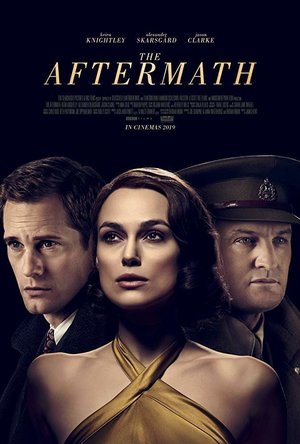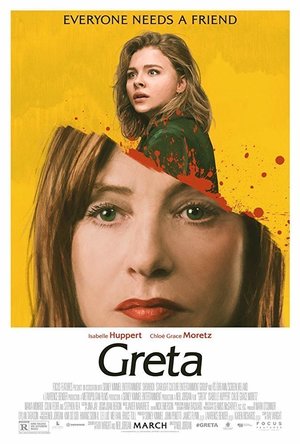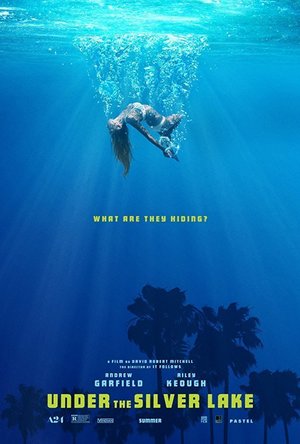Search
Search results
Emma @ The Movies (1786 KP) rated The Aftermath (2019) in Movies
Jun 22, 2019 (Updated Sep 25, 2019)
Is there a period piece that Keira Knightley has ever turned down? After seeing her in Colette I retrieved her from the Nutcracker trash can I'd thrown her into and actually looked forward to whatever I was going to see her in next. I sort of wish it hadn't been this film though.
I'm conflicted. The Aftermath has some great pieces, but at the same time it's rather forgettable. Talking to a friend about films I'd seen this month I already forgot I'd seen it, and that doesn't normally happen this quickly.
Having seen the trailers I had come away with a rather definite idea of what the film was going to be like... I was actually surprised, the wool was properly pulled over my eyes. I had a completely different idea of the outcome. I really don't want to spoil it, if you've seen it message me and we'll waffle about it.
Alexander Skarsgård was incredibly good in this, I think I might be in love. I haven't seen him in anything recently but I might have to finally watch Tarzan. For the most part Stephen is a restrained and sensible character, so when he has an outburst of emotions it's all the more powerful. When he shows the Morgans round his house like a sad estate agent I felt that awkwardness.
Keira Knightley/Rachel isn't the leading lady I was looking for, as a character she is dislikeable. She's quick to judgment and takes for granted and abuses all the privileges that she has. I think this is partly what surprised me about the film, I hadn't expected her to be this way. In a film involving war I wouldn't have expected the female character to be the antagonist.
I'm pleased to see Jason Clarke again, he's going from strength to strength. Lewis Morgan is warm and accepting in contrast to the coldness of his wife. More strong emotions coming from our other male lead. Most feel like they're done perfectly, one outburst stuck out but I'm not sure that "out of character" is quite the right way to describe it.
The movie's handling of the Morgan's son was done nicely with a great link used to tie it together. Getting such a powerful moment out of such a small detail was amazing. The use of prop and flashback scenes came together very well.
The ending though... like the trailer I like that we're given something that doesn't necessarily hold with the expected. (Again, if you've seen it then message me so I can tell you how I wanted it to end.) I can't say I was happy with the end, it flies in the face of the traditional take on these sorts of films. There's an ending I would have preferred Rachel to have over the actual one just so that I could go "Ha! Serves you right!" but it wouldn't have been satisfactory for the other two points of the triangle. I'm not sure that any outcome could have left me content though.
There are some very striking visuals mixed through the film, most take part in the ruins of the city where we see the community living through the devastation of the city. I was intrigued to see that it was a BBC film, they usually have a certain feel to them but it wasn't really present in this.
As much as I enjoyed elements of this I can't say I would be fussed about seeing it again, if anything I think a second watch would remind me how annoying I found the ending.
What you should do
If you want to see Keira Knightley's character disrespecting her marriage then I would suggest watching Colette instead. However, if you want to have some strong feelings about Alexander Skarsgård then definitely see this one.
Movie thing you wish you could take home
It goes without saying that I would like Alexander Skarsgård, but failing that then the ability to play the piano beautifully will have to do.
I'm conflicted. The Aftermath has some great pieces, but at the same time it's rather forgettable. Talking to a friend about films I'd seen this month I already forgot I'd seen it, and that doesn't normally happen this quickly.
Having seen the trailers I had come away with a rather definite idea of what the film was going to be like... I was actually surprised, the wool was properly pulled over my eyes. I had a completely different idea of the outcome. I really don't want to spoil it, if you've seen it message me and we'll waffle about it.
Alexander Skarsgård was incredibly good in this, I think I might be in love. I haven't seen him in anything recently but I might have to finally watch Tarzan. For the most part Stephen is a restrained and sensible character, so when he has an outburst of emotions it's all the more powerful. When he shows the Morgans round his house like a sad estate agent I felt that awkwardness.
Keira Knightley/Rachel isn't the leading lady I was looking for, as a character she is dislikeable. She's quick to judgment and takes for granted and abuses all the privileges that she has. I think this is partly what surprised me about the film, I hadn't expected her to be this way. In a film involving war I wouldn't have expected the female character to be the antagonist.
I'm pleased to see Jason Clarke again, he's going from strength to strength. Lewis Morgan is warm and accepting in contrast to the coldness of his wife. More strong emotions coming from our other male lead. Most feel like they're done perfectly, one outburst stuck out but I'm not sure that "out of character" is quite the right way to describe it.
The movie's handling of the Morgan's son was done nicely with a great link used to tie it together. Getting such a powerful moment out of such a small detail was amazing. The use of prop and flashback scenes came together very well.
The ending though... like the trailer I like that we're given something that doesn't necessarily hold with the expected. (Again, if you've seen it then message me so I can tell you how I wanted it to end.) I can't say I was happy with the end, it flies in the face of the traditional take on these sorts of films. There's an ending I would have preferred Rachel to have over the actual one just so that I could go "Ha! Serves you right!" but it wouldn't have been satisfactory for the other two points of the triangle. I'm not sure that any outcome could have left me content though.
There are some very striking visuals mixed through the film, most take part in the ruins of the city where we see the community living through the devastation of the city. I was intrigued to see that it was a BBC film, they usually have a certain feel to them but it wasn't really present in this.
As much as I enjoyed elements of this I can't say I would be fussed about seeing it again, if anything I think a second watch would remind me how annoying I found the ending.
What you should do
If you want to see Keira Knightley's character disrespecting her marriage then I would suggest watching Colette instead. However, if you want to have some strong feelings about Alexander Skarsgård then definitely see this one.
Movie thing you wish you could take home
It goes without saying that I would like Alexander Skarsgård, but failing that then the ability to play the piano beautifully will have to do.
Emma @ The Movies (1786 KP) rated Greta (2019) in Movies
Jun 22, 2019 (Updated Sep 25, 2019)
I sat down to write up my notes for the weekend's films and I had already forgotten this one. I quite enjoyed it and yet it hasn't really stuck with me at all.
Frances, played by Chloë Grace Moretz, finds a handbag on the subway, unable to hand it in to lost property she takes it home with the intention of returning it the next day. Greta is a lonely widow whose daughter is abroad and she has nothing but her piano and photos for company. When the pair meet they connect immediately and their friendship grows. To say Greta is clingy would be an understatement and when Frances discovers a cupboard full of identical "missing" handbags she knows she needs to get some distance.
Right, so, the idea here relies on someone returning her handbag, admittedly a handbag is less suspicious than a rucksack or a suitcase, but I'm still not convinced. It relies on no one seeing her leave it when she gets up to leave, and no one spotting it when they get on at the stop, and then not a single member of staff being in the subway station to take the bag. Erica says it best, "you call the bomb squad"... yes you do, Erica.
I very much enjoyed the idea of this film, as thrillers go it's a good set up. I'm becoming increasingly frustrated by trailers though, and in this instance I think they gave you too many moments that would have given a greater impact as a surprise. It also exposed an inconsistency.
The trailer shows Frances stuck in a lift as it's being crushed. In the context of the full film it made sense, sort of, but it left the question in the trailer of whether it was slightly sci-fi. While I knew what the whole scene was trying to achieve I felt that it was too confusing given the tone everywhere else.
Isabelle Huppert gives her character of Greta a delightfully creepy vibe, always pleasant and threatening at the same time and Chloë Grace Moretz played the naive Frances convincingly, but... I didn't think either particularly hit the spot. Greta was crazy but not devious enough and Frances was bordering on cliche when it came to her naivety.
There are lots of things that caused me issues, the passage of time being a major one. There's no clear idea of how long anything takes, how long their friendship went for, how long she was kidnapped, and it's surprisingly frustrating. I also am at a loss as to why her father resorts to a private investigator over the police, in my head it's because the police are saying she's a grown up and the messages suggest she's fine, but I don't think that's ever explicitly said.
I was getting very mixed tones from the film, first it was a drama, then a thriller, and then it seemed to want to be a horror. There's one point where it gets a little gruesome and it stuck out like a sore thumb. The very end as well, without trying to give spoilers, shows something I would fully expect to see in a horror movie, and in that setting it's a great way to finish it but in Greta seemed like a step in the wrong direction.
I've mentioned before that I don't over think the film while I'm watching it, I try not to look for the twists in advance, but I actually wrote the ending in my notes. While it was satisfying I was right, it was irritating that it was so obvious.
Like I mentioned above, the concept was great and it left a lot of opportunities for a brilliant thriller, but I feel like it just kept missing the point. A lot of the intrigue was stolen by the trailer and the identity crisis with the genre just held it back from what it could have achieved.
What you should do
It's not a bad watch, certainly catch it when it goes to streaming services.
Movie thing you wish you could take home
The ability to keep a home clutter free like Erica and Frances.
Frances, played by Chloë Grace Moretz, finds a handbag on the subway, unable to hand it in to lost property she takes it home with the intention of returning it the next day. Greta is a lonely widow whose daughter is abroad and she has nothing but her piano and photos for company. When the pair meet they connect immediately and their friendship grows. To say Greta is clingy would be an understatement and when Frances discovers a cupboard full of identical "missing" handbags she knows she needs to get some distance.
Right, so, the idea here relies on someone returning her handbag, admittedly a handbag is less suspicious than a rucksack or a suitcase, but I'm still not convinced. It relies on no one seeing her leave it when she gets up to leave, and no one spotting it when they get on at the stop, and then not a single member of staff being in the subway station to take the bag. Erica says it best, "you call the bomb squad"... yes you do, Erica.
I very much enjoyed the idea of this film, as thrillers go it's a good set up. I'm becoming increasingly frustrated by trailers though, and in this instance I think they gave you too many moments that would have given a greater impact as a surprise. It also exposed an inconsistency.
The trailer shows Frances stuck in a lift as it's being crushed. In the context of the full film it made sense, sort of, but it left the question in the trailer of whether it was slightly sci-fi. While I knew what the whole scene was trying to achieve I felt that it was too confusing given the tone everywhere else.
Isabelle Huppert gives her character of Greta a delightfully creepy vibe, always pleasant and threatening at the same time and Chloë Grace Moretz played the naive Frances convincingly, but... I didn't think either particularly hit the spot. Greta was crazy but not devious enough and Frances was bordering on cliche when it came to her naivety.
There are lots of things that caused me issues, the passage of time being a major one. There's no clear idea of how long anything takes, how long their friendship went for, how long she was kidnapped, and it's surprisingly frustrating. I also am at a loss as to why her father resorts to a private investigator over the police, in my head it's because the police are saying she's a grown up and the messages suggest she's fine, but I don't think that's ever explicitly said.
I was getting very mixed tones from the film, first it was a drama, then a thriller, and then it seemed to want to be a horror. There's one point where it gets a little gruesome and it stuck out like a sore thumb. The very end as well, without trying to give spoilers, shows something I would fully expect to see in a horror movie, and in that setting it's a great way to finish it but in Greta seemed like a step in the wrong direction.
I've mentioned before that I don't over think the film while I'm watching it, I try not to look for the twists in advance, but I actually wrote the ending in my notes. While it was satisfying I was right, it was irritating that it was so obvious.
Like I mentioned above, the concept was great and it left a lot of opportunities for a brilliant thriller, but I feel like it just kept missing the point. A lot of the intrigue was stolen by the trailer and the identity crisis with the genre just held it back from what it could have achieved.
What you should do
It's not a bad watch, certainly catch it when it goes to streaming services.
Movie thing you wish you could take home
The ability to keep a home clutter free like Erica and Frances.

My Talking Dog – Virtual Pet
Games and Entertainment
App
Wanna play with the cutest puppy ever? You can talk to him, play mini games, dog dress up and so...

My Boo Virtual Pet & Mini Game
Games and Entertainment
App
Meet Boo, your very own virtual pet! Enjoy countless hours of fun in this addictive and entertaining...
Bob Mann (459 KP) rated Stan & Ollie (2018) in Movies
Sep 28, 2021
When the laughter has to end.
The problem with any comedy double act is that if illness or death get in the way (think Dustin Gee and Les Dennis; or Morecambe and Wise) the wheels can come off for the other partner. “Stan and Ollie” tells the story of the comic duo starting in 1937 when they reached their peak of global popularity, albeit when Laurel was hardly on speaking terms with their long-term producer Hal Roach (Danny Huston).
As you might guess from this, the emotional direction for the film is downwards, but not necessarily in a totally depressing way. The film depicts the duo’s tour of Laurel’s native country (he was born in Lancashire) and this has its ups as well as its downs.
Not knowing their life story, this is one where when the trailer came on I shut my eyes and plugged my ears so as to avoid spoilers: as such I will say nothing further on the details of the plot.
My wife and I were reminiscing after seeing this flick about how our parents used to crack up over the film antics of Laurel and Hardy. And they were, in their own slapstick way, very funny indeed. The film manages to recreate (impecably) some of their more famous routines and parodies others: their travel trunk gallops to the bottom of the station steps, mimicking the famous scenes with a piano from 1932’s “The Music Box”. “Do we really need that trunk” Hardy deadpans to Laurel.
The turns
There are four star turns at the heart of the film and they are John C. Reilly as Ollie; Steve Coogan as Stan; Shirley Henderson (forever to be referenced as “Moaning Myrtle”) as Ollie’s wife Lucille and Nina Arianda (so memorable as the ‘pointer outer’ in the ‘Emperor’s New Clothes’ segment of “Florence Foster Jenkins“) as Stan’s latest wife Ida.
Coogan and Reilly do an outstanding job of impersonating the comic duo. Both are simply brilliant, playing up to their public personas when visible but subtly delivering similar traits in private. Of the two, John C. Reilly’s performance is the most memorable: he IS Oliver Hardy. Not taking too much away from the other performance, but there are a few times when Coogan poked through the illusion (like a Partridge sticking its head out from a Pear Tree you might say).
Henderson and Arianda also add tremendous heart to the drama, and Arianda’s Ida in particular is hilarious. Also delivering a fabulous supporting role is Rufus Jones as the famous impressario Bernard Delfont: all smarm and Machiavellian chicanery that adds a different shape of comedy to the film.
Another Fine Mess?
Actually, no: it’s one of those pleasant and untaxing cinema experiences that older audiences in particular will really enjoy. However, the film’s far from perfect in my view: the flash-forwards/flash-backs I felt made the story bitty and disjointed; and ultimately the life story of the duo doesn’t have a huge depth of drama in it to amaze or excite, the way that 2004’s “Beyond the Sea” (the biopic of Bobby Darin) did for example. But the film never gets boring or disappoints.
I’d like to say that the script by Jeff Pope (“Philomena“) is historically accurate, but a look at the wikipedia entries for the pair show that it was far from that. Yes, the tours of the UK and Europe did happen, but over multiple years and the actual events in their lives are telescoped into a single trip for dramatic purposes. But I think the essence of the pair comes across nicely. Laurel’s wikipedia entry records a nice death-bed scene that sums up the guy:
“Minutes before his death, he told his nurse that he would not mind going skiing, and she replied that she was not aware that he was a skier. “I’m not,” said Laurel, “I’d rather be doing that than this!” A few minutes later, the nurse looked in on him again and found that he had died quietly in his armchair.”
“Stan and Ollie” has a few preview screenings before the New Year, but goes on UK general release on January 11th. Recommended.
As you might guess from this, the emotional direction for the film is downwards, but not necessarily in a totally depressing way. The film depicts the duo’s tour of Laurel’s native country (he was born in Lancashire) and this has its ups as well as its downs.
Not knowing their life story, this is one where when the trailer came on I shut my eyes and plugged my ears so as to avoid spoilers: as such I will say nothing further on the details of the plot.
My wife and I were reminiscing after seeing this flick about how our parents used to crack up over the film antics of Laurel and Hardy. And they were, in their own slapstick way, very funny indeed. The film manages to recreate (impecably) some of their more famous routines and parodies others: their travel trunk gallops to the bottom of the station steps, mimicking the famous scenes with a piano from 1932’s “The Music Box”. “Do we really need that trunk” Hardy deadpans to Laurel.
The turns
There are four star turns at the heart of the film and they are John C. Reilly as Ollie; Steve Coogan as Stan; Shirley Henderson (forever to be referenced as “Moaning Myrtle”) as Ollie’s wife Lucille and Nina Arianda (so memorable as the ‘pointer outer’ in the ‘Emperor’s New Clothes’ segment of “Florence Foster Jenkins“) as Stan’s latest wife Ida.
Coogan and Reilly do an outstanding job of impersonating the comic duo. Both are simply brilliant, playing up to their public personas when visible but subtly delivering similar traits in private. Of the two, John C. Reilly’s performance is the most memorable: he IS Oliver Hardy. Not taking too much away from the other performance, but there are a few times when Coogan poked through the illusion (like a Partridge sticking its head out from a Pear Tree you might say).
Henderson and Arianda also add tremendous heart to the drama, and Arianda’s Ida in particular is hilarious. Also delivering a fabulous supporting role is Rufus Jones as the famous impressario Bernard Delfont: all smarm and Machiavellian chicanery that adds a different shape of comedy to the film.
Another Fine Mess?
Actually, no: it’s one of those pleasant and untaxing cinema experiences that older audiences in particular will really enjoy. However, the film’s far from perfect in my view: the flash-forwards/flash-backs I felt made the story bitty and disjointed; and ultimately the life story of the duo doesn’t have a huge depth of drama in it to amaze or excite, the way that 2004’s “Beyond the Sea” (the biopic of Bobby Darin) did for example. But the film never gets boring or disappoints.
I’d like to say that the script by Jeff Pope (“Philomena“) is historically accurate, but a look at the wikipedia entries for the pair show that it was far from that. Yes, the tours of the UK and Europe did happen, but over multiple years and the actual events in their lives are telescoped into a single trip for dramatic purposes. But I think the essence of the pair comes across nicely. Laurel’s wikipedia entry records a nice death-bed scene that sums up the guy:
“Minutes before his death, he told his nurse that he would not mind going skiing, and she replied that she was not aware that he was a skier. “I’m not,” said Laurel, “I’d rather be doing that than this!” A few minutes later, the nurse looked in on him again and found that he had died quietly in his armchair.”
“Stan and Ollie” has a few preview screenings before the New Year, but goes on UK general release on January 11th. Recommended.
Paul Chesworth (3 KP) created a post
Feb 20, 2018
TheDefunctDiva (304 KP) rated Alice in Wonderland (2010) in Movies
Sep 26, 2017
A is for Artful
Contains spoilers, click to show
As with another of Tim Burton’s films, Sleepy Hollow, Alice in Wonderland strays significantly from the original material. And, in a vein similar to Sleepy Hollow, decapitation is a much-discussed topic.
Alice is introduced to the audience as a child who has strange dreams. In the subsequent scenes, an older Alice is seen in a carriage with her mother. She is unwittingly on her way to her engagement party, and she is fully expected to accept the offer of marriage from someone who seems quite ill-suited for her. “Your life will be perfect. It’s already been decided,” says her sister Margaret.
Elements of the engagement party offer foreshadowing for the alternate reality Alice soon finds herself in. Instead of accepting her suitor’s proposal, Alice runs away and follows a rabbit wearing a waistcoat into an exceptionally large rabbit hole. There, she is found falling with a variety of household objects, including one particularly friendly piano.
Once in Wonderland, Alice’s world has literally turned upside-down. She falls from her perch on the ceiling to the floor. Alice solves a puzzle of many locked doors, using the expected growing and shrinking mechanisms, and then she emerges into a strange topiary. There she is greeted by the rabbit and other residents of Wonderland, who argue whether this Alice is “the right Alice.”
Many of the traditional characters are found in this Wonderland, but most of the ominous poetry associated with those characters has been omitted. Tweedledum and Tweedledee are introduced, but they don’t seem to serve much purpose. I missed the recitation of “the Walrus and the Carpenter” very much.
Alice insists that the world around her must be a dream, as she is led through oversized mushrooms to a blue caterpillar, voiced by the talented Alan Rickman. Once again, Alice’s destiny is written: the caterpillar reveals a scroll which shows an image of Alice slaying the dreaded Jabberwocky. Indeed, it is her role to become the champion of Wonderland, to rise up and defeat the Red Queen who keeps this horrible beast as a weapon.
Later, we come across a dysfunctional tea party held under the shadow of a dilapidated windmill. Johnny Depp appears as the wild and wide-eyed Mad Hatter. Alice, it seems, is late to her tea just as she was to her engagement party. We learn that there is a whole network of characters, including the White Queen (Anne Hathaway), who wish to bring down the tyrannical Red Queen.
The struggle between the Red and White Queens eventually comes to a head, and Alice bravely accepts her fate to fight the Jabberwocky. And the Jabberwocky is indeed a terrifying entity, as it seems to be part dinosaur and part dragon.
The visual effects in this film were striking. Burton paints a beautiful landscape full of dark, rich colors. Several moments in the film are surreal and disturbing, such as when Alice crosses a moat full of dismembered heads to gain access to the Red Queen’s castle. However, some of the characters, such as the Cheshire cat, had a more cartoonish quality about them that I found off-putting.
The acting and voice-overs in the film were also impressive. Actress Mia Wasikowska was enchanting as Alice. She reflected the vulnerability and the more intrepid characteristics of the young girl quite well. Depp was delightfully creepy as the Mad Hatter. Crispin Glover was effective as the Knave of Hearts, the Red Queen’s lead henchman. And Stephen Fry was a marvelous voice choice for the strange and eerie Cheshire Cat.
The Red Queen is quite the character in this film. Helena Bonham Carter perfectly captures the Queen’s cruelty and absurdity. She delivers the “off with his head” line repeatedly and with gusto. The Queen’s cranium was so large that I was surprised she didn’t fall forward from the weight of it. And I haven’t seen that much blue eyeshadow since the 80s.
The Blu-ray version of this film enhanced the quality of the computer graphic imagery quite well. The special features consisted of interviews of the cast regarding the characters. These interviews contained behind-the-scenes looks at some of the makeup and green screen work done on this film. Though these interviews were enlightening, I would have loved to see more about the production process, since the sets and some characters were entirely computer-generated.
All things considered, Burton’s Alice in Wonderland is a delightful departure from reality. Fans of Burton’s other films are sure to love it.
Alice is introduced to the audience as a child who has strange dreams. In the subsequent scenes, an older Alice is seen in a carriage with her mother. She is unwittingly on her way to her engagement party, and she is fully expected to accept the offer of marriage from someone who seems quite ill-suited for her. “Your life will be perfect. It’s already been decided,” says her sister Margaret.
Elements of the engagement party offer foreshadowing for the alternate reality Alice soon finds herself in. Instead of accepting her suitor’s proposal, Alice runs away and follows a rabbit wearing a waistcoat into an exceptionally large rabbit hole. There, she is found falling with a variety of household objects, including one particularly friendly piano.
Once in Wonderland, Alice’s world has literally turned upside-down. She falls from her perch on the ceiling to the floor. Alice solves a puzzle of many locked doors, using the expected growing and shrinking mechanisms, and then she emerges into a strange topiary. There she is greeted by the rabbit and other residents of Wonderland, who argue whether this Alice is “the right Alice.”
Many of the traditional characters are found in this Wonderland, but most of the ominous poetry associated with those characters has been omitted. Tweedledum and Tweedledee are introduced, but they don’t seem to serve much purpose. I missed the recitation of “the Walrus and the Carpenter” very much.
Alice insists that the world around her must be a dream, as she is led through oversized mushrooms to a blue caterpillar, voiced by the talented Alan Rickman. Once again, Alice’s destiny is written: the caterpillar reveals a scroll which shows an image of Alice slaying the dreaded Jabberwocky. Indeed, it is her role to become the champion of Wonderland, to rise up and defeat the Red Queen who keeps this horrible beast as a weapon.
Later, we come across a dysfunctional tea party held under the shadow of a dilapidated windmill. Johnny Depp appears as the wild and wide-eyed Mad Hatter. Alice, it seems, is late to her tea just as she was to her engagement party. We learn that there is a whole network of characters, including the White Queen (Anne Hathaway), who wish to bring down the tyrannical Red Queen.
The struggle between the Red and White Queens eventually comes to a head, and Alice bravely accepts her fate to fight the Jabberwocky. And the Jabberwocky is indeed a terrifying entity, as it seems to be part dinosaur and part dragon.
The visual effects in this film were striking. Burton paints a beautiful landscape full of dark, rich colors. Several moments in the film are surreal and disturbing, such as when Alice crosses a moat full of dismembered heads to gain access to the Red Queen’s castle. However, some of the characters, such as the Cheshire cat, had a more cartoonish quality about them that I found off-putting.
The acting and voice-overs in the film were also impressive. Actress Mia Wasikowska was enchanting as Alice. She reflected the vulnerability and the more intrepid characteristics of the young girl quite well. Depp was delightfully creepy as the Mad Hatter. Crispin Glover was effective as the Knave of Hearts, the Red Queen’s lead henchman. And Stephen Fry was a marvelous voice choice for the strange and eerie Cheshire Cat.
The Red Queen is quite the character in this film. Helena Bonham Carter perfectly captures the Queen’s cruelty and absurdity. She delivers the “off with his head” line repeatedly and with gusto. The Queen’s cranium was so large that I was surprised she didn’t fall forward from the weight of it. And I haven’t seen that much blue eyeshadow since the 80s.
The Blu-ray version of this film enhanced the quality of the computer graphic imagery quite well. The special features consisted of interviews of the cast regarding the characters. These interviews contained behind-the-scenes looks at some of the makeup and green screen work done on this film. Though these interviews were enlightening, I would have loved to see more about the production process, since the sets and some characters were entirely computer-generated.
All things considered, Burton’s Alice in Wonderland is a delightful departure from reality. Fans of Burton’s other films are sure to love it.
Chris Sawin (602 KP) rated Under the Silver Lake (2018) in Movies
Jul 6, 2019
In David Robert Mitchell’s (It Follows) Under the Silver Lake, Andrew Garfield portrays a jobless and lethargic young man named Sam. Apart from his obsession with conspiracy theories and finding obscure messages in common pop culture, Sam typically spies on his topless and bird-loving neighbor. He also blatantly ignores the fact that he’s facing eviction in five days for unpaid rent. His current infatuation is a zine entitled Under the Silver Lake, which seems to mirror what’s currently transpiring in Los Angeles. Sam develops a crush on his new neighbor named Sarah (Riley Keough), who seems to disappear without a trace overnight. What begins as an investigation into Sarah’s current whereabouts evolves into something deeply rooted in the peculiar.
There’s a lot to digest with Under the Silver Lake. Not only is the story constructed on finding clues and deciphering the bizarre, but the film itself is also loaded with homage to famous music, film, and people. Nirvana, The Legend of Zelda, Nintendo Power, and Spider-Man are just a few references in the film and that doesn’t cover the blatant influence of films such as Rear Window or 2001: A Space Odyssey. What you have to ask yourself, and this is probably what makes the film so polarizing, is if what lays between the admiration for popular culture a worthwhile experience?
What you can appreciate is Andrew Garfield’s performance. Sam is so bored with his uneventful existence that he tries to find hidden meaning in everyday items. He is basically a stalker fueled by paranoia and consistent lusting of whatever woman is closest to him. When sex isn’t an option for Sam, he masturbates and somehow this becomes a common theme of the film. The first thing you ever pleasured yourself to is suddenly a conversation piece. Garfield has an unusual demeanor as Sam, but never really comes off as creepy. The method in which the story keeps snowballing into something bigger with more and more connections helps Sam’s case. Sam beats the snot out of a kid who keyed a giant penis ejaculating onto the hood of his black GT Mustang and you only seem to like him more because of it.
The fact of the matter is you also become invested in Sam’s discoveries. Despite what you feel about Under the Silver Lake as a film, it’s still unpredictable and intriguing even with its 139-minute duration. With its abrupt camera movements, a kamikaze squirrel, a serial dog killer on the loose, pets named after soda, the discovery of saltines and orange juice being one of the most unique combinations ever, a gory dream sequence, animated zine stories, people barking like dogs, the map on the back of a cereal box being the answer to everything, a seething hatred for the homeless, a way too impressive piano medley, and an almost unrecognizable Topher Grace as a reliable friend, Under the Silver Lake feels like it is overloaded with these overwhelmingly precise details that don’t necessarily lead to anything substantial.
On first watch, it’s impossible to decipher if Under the Silver Lake is destined to be a cult classic or a misguided neo-noir mystery. David Robert Mitchell knows how to introduce elements of comedy, mystery, and drama, but that final product is what leaves you scratching your head. Maybe this gets better with multiple viewings and you find more Easter eggs with each watch or everything connects differently in your head after knowing what direction the story is headed in. In the meantime though, Under the Silver Lake mostly feels like a nearly two and a half hour session of stoner ramblings that can’t decide whether to be Brick, Inherent Vice, or Southland Tales; even The Homeless King feels like a side story lifted from Terry Gilliam’s The Fisher King.
What’s happening directly in Sam’s world isn’t what matters most in Under the Silver Lake. He’s more worried about Sarah and Los Angeles than he is about not having a job or possibly a place to live in a matter of days. The outside world is far more interesting to Sam because it’s that, “The grass is always greener,” kind of mentality. Sam is consumed by Sarah because she is the one woman in the film he doesn’t get to sleep with. Having everlasting discussions of what your topless neighbor’s parrot is saying is far more humorous than revealing anything remotely personal. Becoming entangled in this crazy spider’s web of a conspiracy is far more interesting than living a boring existence. Sam makes the most out of nothing, literally. Under the Silver Lake is this spellbinding enigma of a film that is equally stimulating as it is mystifying.
There’s a lot to digest with Under the Silver Lake. Not only is the story constructed on finding clues and deciphering the bizarre, but the film itself is also loaded with homage to famous music, film, and people. Nirvana, The Legend of Zelda, Nintendo Power, and Spider-Man are just a few references in the film and that doesn’t cover the blatant influence of films such as Rear Window or 2001: A Space Odyssey. What you have to ask yourself, and this is probably what makes the film so polarizing, is if what lays between the admiration for popular culture a worthwhile experience?
What you can appreciate is Andrew Garfield’s performance. Sam is so bored with his uneventful existence that he tries to find hidden meaning in everyday items. He is basically a stalker fueled by paranoia and consistent lusting of whatever woman is closest to him. When sex isn’t an option for Sam, he masturbates and somehow this becomes a common theme of the film. The first thing you ever pleasured yourself to is suddenly a conversation piece. Garfield has an unusual demeanor as Sam, but never really comes off as creepy. The method in which the story keeps snowballing into something bigger with more and more connections helps Sam’s case. Sam beats the snot out of a kid who keyed a giant penis ejaculating onto the hood of his black GT Mustang and you only seem to like him more because of it.
The fact of the matter is you also become invested in Sam’s discoveries. Despite what you feel about Under the Silver Lake as a film, it’s still unpredictable and intriguing even with its 139-minute duration. With its abrupt camera movements, a kamikaze squirrel, a serial dog killer on the loose, pets named after soda, the discovery of saltines and orange juice being one of the most unique combinations ever, a gory dream sequence, animated zine stories, people barking like dogs, the map on the back of a cereal box being the answer to everything, a seething hatred for the homeless, a way too impressive piano medley, and an almost unrecognizable Topher Grace as a reliable friend, Under the Silver Lake feels like it is overloaded with these overwhelmingly precise details that don’t necessarily lead to anything substantial.
On first watch, it’s impossible to decipher if Under the Silver Lake is destined to be a cult classic or a misguided neo-noir mystery. David Robert Mitchell knows how to introduce elements of comedy, mystery, and drama, but that final product is what leaves you scratching your head. Maybe this gets better with multiple viewings and you find more Easter eggs with each watch or everything connects differently in your head after knowing what direction the story is headed in. In the meantime though, Under the Silver Lake mostly feels like a nearly two and a half hour session of stoner ramblings that can’t decide whether to be Brick, Inherent Vice, or Southland Tales; even The Homeless King feels like a side story lifted from Terry Gilliam’s The Fisher King.
What’s happening directly in Sam’s world isn’t what matters most in Under the Silver Lake. He’s more worried about Sarah and Los Angeles than he is about not having a job or possibly a place to live in a matter of days. The outside world is far more interesting to Sam because it’s that, “The grass is always greener,” kind of mentality. Sam is consumed by Sarah because she is the one woman in the film he doesn’t get to sleep with. Having everlasting discussions of what your topless neighbor’s parrot is saying is far more humorous than revealing anything remotely personal. Becoming entangled in this crazy spider’s web of a conspiracy is far more interesting than living a boring existence. Sam makes the most out of nothing, literally. Under the Silver Lake is this spellbinding enigma of a film that is equally stimulating as it is mystifying.






